Creating a Newscast as an ESL Lesson
- Basic Conversations for English Language Learners
- Pronunciation & Conversation
- Writing Skills
- Reading Comprehension
- Business English
- Resources for Teachers
- TESOL Diploma, Trinity College London
- M.A., Music Performance, Cologne University of Music
- B.A., Vocal Performance, Eastman School of Music
Media is an ever-present reality and one that students are intimately familiar with. As such, diving into the media landscape offers multiple avenues for interesting lessons that will hold students' attention. You can start by studying media-related words so that students are familiar with the basics. From there, lesson plans can revolve around anything from watching news videos on YouTube to publishing a class newspaper. One activity that helps students cover a variety of media related themes is to have students create and act out a newscast. The larger the class, the more roles students can take on. Perhaps your class might even put up the final version online.

ESL Newscast Lesson Plan Breakdown
- Aim : Develop a working knowledge of vocabulary related to media
- Activity : Creating a newscast
- Level : Intermediate to advanced
Lesson Activities
- Study media-related vocabulary covering the basics of printed and broadcast video.
- Discuss different roles on news broadcasts including anchorpersons, meteorologists, and sports reporters.
- Compare and contrast printed and broadcast media and how they are currently used in our daily lives.
- Watch a video on YouTube or on TV of a typical newscast together as a class. It's not necessary to watch an entire broadcast. However, students should have a chance to become familiar with a range of reports.
- Watch the newscast a second time and ask students to take note of typical phrases used to introduce various reports and reporters, as well as make transitions.
- Review transition phrases in small groups with students matching language functions to appropriate phrases.
- Ask students to write out two alternate phrases for each language function.
- As a class, review possible phrases. Write phrases on the whiteboard, or take note in a document to print out for students.
- Ask groups to read a transcript of a typical broadcast. I've included an easy version below, but advanced classes should be able to handle actual broadcast transcripts.
- Next, students script out a short newscast in groups of four to six. One student should take on the role of anchorperson, one as the weatherperson, another as a sports reporter. For larger groups, add various reporters as required. For example, one group might have a gossip reporter from Hollywood, another group might have a reporter on assignment in China, etc.
- Ask students to work together to write a short newscast with each student responsible for his or her own role / report.
- Review students' scripts as needed and help out with transitional language.
- Have students practice the newscast until they can deliver the news comfortably with little reference to the script.
- Enjoy the newscasts as a class. If it's really good, share the newscast online.
- Afterwards, repeat the fun with this lesson on writing dramatic scripts as a class.
Newscaster Language
Match the following purpose to the jargon phrases that follow. Once you've matched the phrases, come up with two additional phrases that might be used to accomplish the same function:
- Opening the newscast
- Announcing the headlines
- Introducing the weather
- Cutting to a commercial
- Transitioning to a new story
- Introducing live coverage
- Introducing the sports segment
- Interrupting the newscast for breaking news
- Using pleasant small talk to finish the news
- Signing off from the broadcast
Broadcast Journalism Jargon
- Excuse me, we have a developing situation ...
- Good evening and here is tonight's important news.
- Hi Steve, we're on the ground here in downtown ...
- How about that game last night!
- It's pretty wet out there, isn't it?
- Let's get out there and enjoy some of the good weather.
- Let's turn to a story about ...
- Stay tuned, we'll be right back.
- Thank you for tuning in. We'll be back at eleven with important updates.
- Tonight's stories include ...
(Answer Key Below)
Example News Transcript
Read this transcript and take note how transitional phrases are used during a news broadcast. Once you have finished, plan your own newscast with classmates.
Newscaster Language Answer Key
- Standard Lesson Plan Format for ESL Teachers
- Future Tenses "Going to" vs. "Will"
- Violence in the Media Needs To Be Regulated
- Writing Informal Emails and Letters
- Vocabulary Chart ESL Lesson Plan
- Lesson Plan: Label Sentences with Parts of Speech
- Grammar Lesson: Tense Review
- Useful English Phrases for Running a Business Meeting
- Learning Pronouns
- Food Lesson for an ESL Learner
- How to Teach the Present Continuous to ESL Students
- Proper Usage of "That" in English
- Teaching Telephone English
- ESL Lesson Plan: How to Use "Have"
- Reading and Writing Newspaper Articles ESL Lesson
- ESL Lesson Plan: Travel Plans

- All topics A-Z
- Grammar
- Vocabulary
- Speaking
- Reading
- Listening
- Writing
- Pronunciation
- Virtual Classroom
- Worksheets by season
- 600 Creative Writing Prompts
- Warmers, fillers & ice-breakers
- Coloring pages to print
- Flashcards
- Classroom management worksheets
- Emergency worksheets
- Revision worksheets
- Resources we recommend
- Copyright 2007-2021 пїЅ
- Submit a worksheet
- Mobile version
- PRO Courses Guides New Tech Help Pro Expert Videos About wikiHow Pro Upgrade Sign In
- EDIT Edit this Article
- EXPLORE Tech Help Pro About Us Random Article Quizzes Request a New Article Community Dashboard This Or That Game Popular Categories Arts and Entertainment Artwork Books Movies Computers and Electronics Computers Phone Skills Technology Hacks Health Men's Health Mental Health Women's Health Relationships Dating Love Relationship Issues Hobbies and Crafts Crafts Drawing Games Education & Communication Communication Skills Personal Development Studying Personal Care and Style Fashion Hair Care Personal Hygiene Youth Personal Care School Stuff Dating All Categories Arts and Entertainment Finance and Business Home and Garden Relationship Quizzes Cars & Other Vehicles Food and Entertaining Personal Care and Style Sports and Fitness Computers and Electronics Health Pets and Animals Travel Education & Communication Hobbies and Crafts Philosophy and Religion Work World Family Life Holidays and Traditions Relationships Youth
- Browse Articles
- Learn Something New
- Quizzes Hot
- This Or That Game New
- Train Your Brain
- Explore More
- Support wikiHow
- About wikiHow
- Log in / Sign up
- Education and Communications
How to Create a Newscast
Last Updated: December 2, 2022 Fact Checked
This article was co-authored by wikiHow Staff . Our trained team of editors and researchers validate articles for accuracy and comprehensiveness. wikiHow's Content Management Team carefully monitors the work from our editorial staff to ensure that each article is backed by trusted research and meets our high quality standards. This article has been fact-checked, ensuring the accuracy of any cited facts and confirming the authority of its sources. This article has been viewed 148,346 times. Learn more...
A newscast is a group of news segments that have been edited together. A typical newscast is 22 minutes long to allow time for advertisements. You may decide to create a newscast for a class or as a fun project with friends. Start by assigning roles for the newscast, like an anchor, reporter, and a producer. Then, write and present the newscast so it is a concise collection of journalism for viewers to enjoy.
Assigning Roles

- If you are working with a large group of people, you may ask two people to serve as producers for the newscast. That way, the work of organizing the newscast is shared between two people.

- Another option is to ask each reporter to write their own news segment.

- You can choose two people to act as anchors for the newscast. The anchors can then take turns introducing the news segments.

- If you have a limited number of reporters, you may ask the reporters to cover more than one news story.
Writing the Newscast

- For example, the anchor introduction might be, “Good morning and welcome to the local news. Today’s stories include the heartwarming tale of a girl and her pet turtle, a look at rising employment levels, and a clip of the Hurricane’s win at the football championships last night.”

- For example, you may have a sports news segment like, “The Hurricane’s held back the Cleveland Jets to take the championship on Sunday night. Star forward Kit Hunt racked up a record 25 assists in the first half of the game. A dramatic penalty kick off decided the win for the Hurricane’s, who are 0-5 so far in the season.”

- For example, if there are two news stories about robberies in the local area, you may include both news stories.

- Avoid sentences longer than two lines and run-on sentences. Use simple terms that are accessible for the audience.

- Choose a segment that has powerful visuals or is very current and in the moment as the first news segment. For example, you may pick a news story about a fire that occurred last night in a local school as the opening segment.
- Some newscasts start with current weather conditions to keep viewers watching and show them something relevant right away.
- Do not try to link together news segments that are clearly different or unconnected. Make the order as organic and natural as you can. Keep the viewer in mind as you organize the segments.

- For example, the anchor may say, “Now, let’s turn to a heartwarming story about a young girl and her pet turtle, rescued from a burning building late last night. Our city beat reporter Joanna has more.”

Presenting the Newscast

- The anchor can also hold cards with notes for each segment and read from those.

- Have the anchors to maintain eye contact with the camera during the newscast. They should demonstrate relaxed body language, with their shoulders back, their chin up, and their hands resting on the news desk.

- If you know how to edit video , you can also shoot the newscast in multiple takes and edit it together to create an organized newscast.

Expert Q&A
You might also like.

- ↑ https://www.learnesl.net/newscasting-script-for-the-introduction/
- ↑ https://www.thoughtco.com/creating-a-newscast-esl-lesson-1212280
- ↑ http://www.write-out-loud.com/cue-cards.html
About This Article

- Send fan mail to authors
Reader Success Stories
Nov 18, 2019
Did this article help you?
Nura Ahmed Audi
May 21, 2021
Klarissa Hajenstok
Nov 16, 2022
Sarwinhi Supuramaniam
Jul 12, 2020
Lexi Bowman

Featured Articles

Trending Articles

Watch Articles

- Terms of Use
- Privacy Policy
- Do Not Sell or Share My Info
- Not Selling Info
Get all the best how-tos!
Sign up for wikiHow's weekly email newsletter
- Sign Up, It's Free
Screen recorder
Record your screen for free.
Video editor
Easily edit your videos for free.
- Video & Image Hosting
Share & protect your content with our content management platform.
- Screenshots
Instantly capture and annotate your screen.
Image editor
Edit screenshots & imported images within minutes.
Video quizzing
Engage with your audience through quiz questions, ratings, and polls.
Streamline video creation with storyboards and scripts.
Stock Library
Explore videos, images and music.
Understand your audience with advanced video analytics.
- View all tools
- View all integrations
Bring lessons to life through videos and images.
Teaching Resources
Certifications, webinars, and ideas for educators.
Schools & Districts
Create and collaborate across your schools.
Integrations
Integrate with your top tools and learning management platforms (LMS).
Guide and empower future generations.
Education Pricing
Empowering students and teachers to collaborate at a discounted price.
- Customer Support
- See all business solutions
Business Resources
Certifications, webinars, tips, and insights.
Integrate with your everyday tools and your team's workflow.
Collaboration tools, stock photography, branded player, and more.
Read our latest articles on video creation and sharing.
Tutorials & Training
We'll walk you through our product features and share tips & tricks.
What's new
Stay updated with the latest features and releases.
- Help center
Search our support articles, frequently asked questions, or reach out for help.
Earn a Badge
- Sign Up, It's Free !!
Edit with our intuitive video editor.
Edit screenshots & uploaded images within minutes.
Share & protect your videos and image with our content management platform.
The all-in-one video creation and sharing platform.
Integrate with your favorite tools and use video to communicate.
Stay Updated with the latest features and releases.
Become a ScreenPal certified educator.
- Tips & Tricks

Create Your Own Student Newsroom For Learning
Li ghts, Camera, Action! It’s time to create your own student newsroom. A student newsroom is a great way to increase engagement, creativity, and learning within the classroom. What’s even better is that your students are the video producers of their own newscast.
You can guide students in their learning by assigning stories or topics. Help them stretch their creative minds. Here are just a few tips to turn your class into a hustling, bustling newsroom.
Be the Editor-In-Chief
Put your Editor-In-Chief hat on, and start assigning roles to each of your students. This helps students take responsibility of their role and holds them accountable for work that’s assigned in class. Have a list of roles including news anchors, producers, writers, reporters, video editors and general production staff. You can change their roles on a weekly basis so that students experience work at all levels.
You can record a quick explainer video to demonstrate what each role does and what they are responsible for. You may want to showcase an example of the job from the ‘real’ world. Grab a video from YouTube or your local news station and add it to your explainer video to illustrate what’s expected from the job.
Create an atmosphere for news

You can group your students into teams, and designate each a working area. For example, have your video editors work in the ‘edit bay.’ You can also have your producers work alongside your writers to increase student collaboration of stories.
If you’re learning remotely, you can also assign students their own roles and they can begin to create their own video stories at home. You can turn to your favorite news station to get ideas on how they are reporting in a remote setting. For example, CNN anchors are reporting from separate locations with a green screen background behind them.
Brainstorm and research together
The day begins with the brainstorming meeting. Have students walk into your meeting with story ideas. This helps increase class participation. You’ll soon find enthusiastic students pitching ideas for the student newscast.
You can also help students come up with story ideas. Go over current news and events. Have them research class topics and report about them. Use this valuable class time to answer questions and help boost confidence in their stories.
Turn on the visuals
Take the creativity to the next level by designing visuals for your newscasts. Have your creative team of students collaborate with reporters and producers on the ‘look’ of the newscast.
You can use the green screen background and add in a creative image to illustrate each story that’s being presented. You can also use ScreenPal’s Overlay Rich Text feature to create animated title graphics for the newscast.
If you need to find the perfect visual, ScreenPal has a stock library filled with hundreds of thousands of images and videos your students can use. They can get creative with the amount of visuals they can use. Just add an image or insert a video from the stock library.
Turn to scripts to stay organized
The story is almost done. All your student needs to do is record their audio over their script. There’s a great feature in ScreenPal that makes it easy to organize and record scripts. The Scripted Recordings feature allows students to record their voice and add video to their story.
It’s an easy line-by-line creation process. Simply copy and paste the script into Scripted Recordings.
Students are able to create a video story, all in one platform.
Imagination comes alive with the video editor

Students can add images, text, arrows and more . If they need to update a story, they can import previous recordings or videos they have done into their new video. They can also insert videos from other devices to enrich the topic.
With the video editor, students will learn useful editing skills as they enhance and polish their videos. They’ll be able to take responsibility for their creativity and have a great way to show it off in class.
The news for learning
Busy reporters are often kicked off smaller stories to cover breaking news. Get in on the action, by creating your own breaking news videos. You can use the screen and webcam recorder to showcase a student reporting on a current event.
You can also use the webcam to record interviews with other students. Ask them their thoughts on world news or what’s happening on campus. This video interaction is a great way to increase their level of creativity.
By giving them easy tools to create, you are helping students become engaged in their learning. All you need to do is turn the camera on them and say, “Lights, Camera, Action!”

Community Education

Education Tips & Tricks
Capture, create and share
- Screen Recorder
- Video Messaging
- Storyboards
- Video Editor
- Image Editor
- Video Quizzing
- Video Analytics
- Schools & districts
- Higher education
- Resources for educators
- LMS integrations
- Customer support
- Development
- Account management
- Resources for business
- Tutorials & training
- Webinars & events
- Developer SDK (API)
- Webcam test
- Individuals & business
- Quote for business
- Quote for education
- Contact Sales
- Partnerships
- Media assets
- Our Mission
Using a School News Program to Promote Positivity During the Pandemic
An elementary school newscast is bringing kids together and giving them a reason to smile during a tough year.
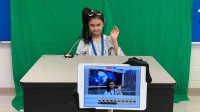
This year, our school reopened on a hybrid schedule, which resulted in a bizarre combination of excitement, joy, anxiety, and grief over how drastically “back to school” had changed. We were back together, but only halfway, and many of our students had opted for full-time virtual school. Even on the days that students enjoyed being together, they were masked, separated by plexiglass, and restricted to air hugs and elbow bumps. Social and emotional learning rose to a whole new level of importance, but establishing a real connection was more difficult than ever.
For us, our morning news program became an important piece of the puzzle.
Increasing Student Engagement and Setting a Positive Tone
It feels normal: While we celebrated the innovation and resilience of our students and staff in adapting to hybrid learning, we found surprising comfort in the things that didn’t have to change. The school news looks and sounds like it always has. We say the Pledge of Allegiance and hear the lunch choices before we get to work. That familiarity has done wonders for our sense of security in a changed environment.
It provides a shared experience, even when we aren’t physically together: Sharing video links via Google Classroom helped fractured classes feel connected during hybrid instruction. With classes learning and traveling in “family groups” during face-to-face instruction, for many students, the morning news is the only glimpse they get of classrooms and grade levels outside of their own. Students could start their e-learning days at home in the same way that their classmates were starting in the school building, and our students in virtual school could watch with their online classes as well.
It’s a collaborative project that we can do safely: As a STEAM (science, technology, engineering, arts, and math) school, we take a great deal of pride and joy in group challenges and hands-on projects. As we find ways to help students safely collaborate in the classroom, the school news was one low-risk way to bring teamwork back.
It’s fun, and we all need that right now: Our school news helps us to start each day on a positive note. We announce and celebrate student achievements. We include a “Joke of the Day” segment and a blooper reel on Fridays. These shared laughs are some of the most valuable content that we pack into our broadcasts, lightening the load in this emotionally heavy time.
Another positive aspect of this project is that a school news program doesn’t have to cost much in terms of your budget or instructional time. Top-of-the-line video and sound equipment are nice, but not necessary for success. We record with an iPad Mini and a plug-in microphone. But a smartphone or a laptop with a camera is all you really need.
Strategies and Resources to Start a School Newscast
Apps like Green Screen by Do Ink and web-based resources like Animoto are great for making a low-budget production look more professional. I use the Green Screen app to add a newsroom background image to our broadcast and Animoto to create a quick intro for our show. My actual green screen is several yards of inexpensive green fabric that hangs on the wall. Green paper or a painted green wall would also work with the app. Again, these apps add nice, extra effects to our videos, but neither is a necessity. The school news can be just as impactful if students film themselves with a laptop on a desk.
Social distancing is required—and completely manageable—while filming the news. All students and classes are invited to participate. Some days, my news crew is a small group of seven or eight students, but often the whole class (up to 18 students) will come in to participate or observe. Everyone who wants to be on camera gets the chance. Even when working with an entire class on a recording, I film only one student at a time. Other students sit a minimum of six feet apart throughout the classroom and keep their masks on until they are seated at the news desk. Each student sits in their own chair (or stands) behind the news desk, which is wiped down to sanitize between takes.
Pre-Covid, our news was part of a fifth-grade club, which could meet only twice a week. We filmed everything in advance out of necessity. This year, I’ve opened the morning news up to all grades and classes. With every grade level operating on a different schedule, recording in advance is still the best fit for our needs. Teachers can request specific days and times to film via a Google form, and I schedule times with teachers as I receive them. Most classes record the news for the following day. This gives me plenty of time to edit and send video links to teachers.
I send all prerecorded news videos to our teachers and post them on our school website for our virtual families to access as well. Google Drive and YouTube are easy ways to share videos (but make sure you have parent permission before doing so!). With YouTube, I set all of our videos to be unlisted. That way, anyone with access to the link can view it, but they are not searchable.
Editing your video doesn’t have to be complicated. When our production was run almost entirely by fifth graders, they used Movie Maker (which has been updated to Windows Photos on newer Windows devices) for editing because it was fairly easy to learn and accessible on student laptops. I continue to use it myself, because it allows me to easily combine videos from multiple sources. If you are using an Apple device, iMovie works similarly.
Our school news program hasn’t solved all of our problems, but it has had a huge impact on our morale as we face each new, challenging day. It’s a low-cost and efficient way to promote student engagement, collaboration, and social and emotional growth in a time when they are greatly needed.

National Institute for Learning Outcomes Assessment
- Mission & Vision
- National Advisory Panel
- NILOA Staff
- Partner & Collaborating Organizations
- Occasional Papers
- Assessment in Practice
- Case Studies
- Assignment Library
- Featured Assignments
- Assignment Charrette
- Equity Responses
- Transparency Framework
- Excellence in Assessment
- Evidence-Based Storytelling
- Featured Websites Archive
- Curriculum Mapping
- Learning Recognition Collaborative
- Degree Qualifications Profile
- Assessment Resources
- Newsletters
- NILOA Surveys Archive
- Resources for Newcomers
- LARC Assessment Modules
- Questions at Hand
- Audience Type
Media Law Newscast Assignment
Jacquelyn Arcy
Department of Communication
Saint Xavier University
Arcy, J. (2016). Media law newscast assignment. Saint Xavier University.
Description
The Media Law Newscast Assignment is a research-based production where students work in small groups to research, analyze, and frame a current issue in media law. Each group of 4-5 students produces a 4-6 minute audio or audio-visual news segment to present their research to the class.
The learning objectives for this assignment include: 1) collecting research, 2) synthesizing and organizing research for a general audience, 3) applying principles of journalism ethics, and 4) using production skills to present an issue in a clear, concise, and engaging manner. This assignment assesses the DQP proficiencies in Applied and Collaborative Learning and Communicative Fluency.
Background and context
The Media Law Newscast Assignment was designed for a 300-level Communication course, taken primarily by Communication Majors in the third or fourth year of their Bachelor’s degree. It is the final project in the course and is used to assess students’ ability to synthesize research, apply theories and frameworks from the course, and present research in an audio-visual format. The course typically has 20-25 students split into 4-5 groups of 5.
At the beginning of the semester, I put students into small groups using a self-assessment worksheet that evaluates their production skills, experience, and interest in course topics. I form groups with similar topical interests and varied production skills, with at least one student in each group who has taken a prior video production course. Student groups then decide on three key components of their project: 1) the case or issue they will cover related to a topic from the course (for instance if they are interested in libel they might choose a recent Twitter libel case); 2) the organizational format (either persuasive or informative), and 3) the production format (either audio or audio visual). These decisions are based on student’ ethical consideration of what topic, organization, and format will best serve a general audience and effectively convey their message.
As we move through the curriculum, students work individually and collaboratively to research their topic. In class, I provide students with research lessons on how to write research questions, brainstorm key words, use online databases, and review sources. Student groups compile their research into an annotated bibliography that is turned in and evaluated with feedback from the instructor. The research component of the assignment assesses the DQP Applied and Collaborative Learning outcome by evaluating students’ ability to conduct research; apply course concepts and theories to analyze the laws, precedents, and ethics that impact their specific issue; and work as a team.
Next, students synthesize their research into an outline with a thesis statement and 3-5 main points. The instructor provides feedback for each groups’ outline to ensure they include the relevant facts, history, discussion points, and opinions to sufficiently support their thesis. To prepare students for the production component of the assignment, I deliver brief in-class lessons on script writing, set design, recording, and editing, and bring in experts from the University’s media services office for a production tutorial. Students then work together to select audio and/or audio-visual evidence to advance their argument, write a production plan, and a final script. I provide another round of feedback on the script with comments on its content and organization. The organization and production components of the assignment assesses the Communication Fluency outcome by evaluating students’ ability to craft sustained, coherent arguments, narratives or explications of issues, problems or technical issues and processes, in writing and at least one other medium, to general and specific audiences (DQP Intellectual Skills).
At the end of the semester, student groups produce their newscast and screen them for class. The final project requires an oral presentation to the class, a self and group evaluation, and a written reflection. Each of these components requires students to use communication theories to articulate the legal and ethical dilemma’s involved in media research, reporting, and production, measuring the DQP Communication Fluency proficiency to articulate an approach to resolving a social, personal or ethical dilemma (DQP Intellectual Skills).
Alignment and scaffolding
The Media Law Newscast Assignment is the final project in the Media Law course. As such, it relies upon specific knowledge and skills scaffolded throughout the semester in media law and journalism ethics. At Saint Xavier University, Communication majors are required to take an introductory media production course and this assignment builds on students’ past production skills.
This assignment is designed to assess student’s advanced research skills and utilizes previous coursework at Saint Xavier University’s Department of Communication that scaffolds learning outcomes in message construction, analysis, and communication self-efficacy through assignments that lay a foundation in constructing outlines and arguments, self-and peer evaluation, and effective delivery methods (see Paxton’s Ethnography of Communication). These skills are honed through individual and group research projects and presentations in subsequent classes including this Media Law course. This assignment prepares students for the research, argument construction, and production skills required for the Department of Communication’s final capstone project, Senior Seminar (see Robinson Audio or Video Production Capstone Project).
Reflections
I have found the Media Law Newscast Assignment to be a successful tool for engaging students in the research, analysis, and production process. It is also presents a set of challenges for students and instructors. Some groups face challenges associated with organizing and distributing labor when working collaboratively. I have found several tools useful for combating these challenges including setting a timeline for each component of the assignment so that student groups stay on schedule, providing feedback for each component to ensure groups are meeting learning outcomes, and holding regular check-in meetings with student groups to evaluate group process. An additional tool used to measure the distribution of labor in each group is an individual log of time on task, paired with an individual evaluation form where each student provides a quantitative grade and qualitative assessment for themselves and other group members (turned in privately to the instructor). The average group assessment makes up 15% of the students’ final assignment grade.
I have also found that the process of researching an unfolding current event reported across multiple news outlets challenged students. To help students manage their research, I integrated mini-tutorials into the curriculum with corresponding worksheets to help students brainstorm research questions and keywords, search databases, and synthesize research. I encourage students to set up Google alerts for key words to stay up to date on their case within preset time limits (research conducted between week 8 and 11) as not to overwhelm students.
Another potential challenge for instructors is students’ technological expertise. At Saint Xavier University, all Communication majors take an introductory audio-visual production course so they each have experience with recording equipment, script writing, visual techniques, and editing software. For courses without this prerequisite, instructors could build in a week of instruction to cover basic concepts in audio-visual production and introduce a user-friendly editing program like iMovie. For instructors without production experience, campus resources like media and production services, production instructors and professionals, and campus computer labs with editing software are helpful. An alternative project could be an in-class performance of the newscast.
Through the assignment design charrette processes and one semester of teaching, the assignment directions have been clarified and the timeline has been extended to further scaffold learning outcomes and skills.
Please select an option
The assignment library and the assignments within are licensed under a Creative Commons Attribution 4.0 International License . By clicking “Ok” you agree to cite each assignment (including modifications), with the provided citation on the assignments downloaded from this site.
Privacy Overview

broadcast journalism writing activities
All Formats
Resource types, all resource types.
- Rating Count
- Price (Ascending)
- Price (Descending)
- Most Recent
Broadcast journalism writing activities

Broadcast Journalism Writing Bundle

Preparing and Writing for a Video Broadcast ( Journalism , Mass Media)

Writing for Broadcast | Broadcast Journalism

Broadcast Journalism Bell Ringers
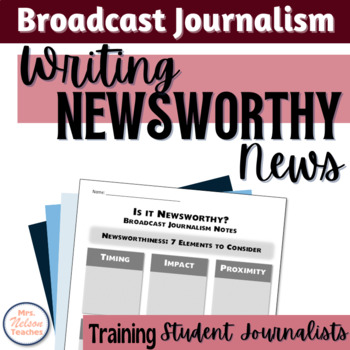
Writing Newsworthy News Stories | Broadcast Journalism


Journalism : SLANTED: Analyzing and Writing the News: Lessons and Activities

- Internet Activities
- Easel Activity
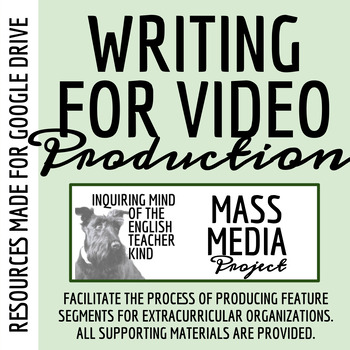
Preparing and Writing for a Video Broadcast ( Journalism , Mass Media) - Google
- Google Drive™ folder

Broadcast Journalism Stand-Up Project
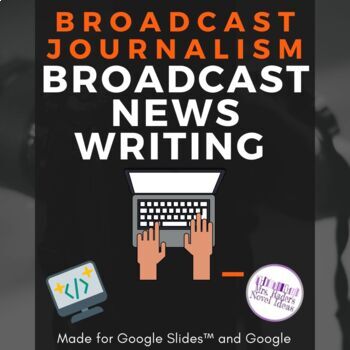
Broadcast Journalism : Broadcast News Writing

Broadcast Journalism : Broadcast News Writing Quiz

Introduction to Broadcast Journalism Bundle
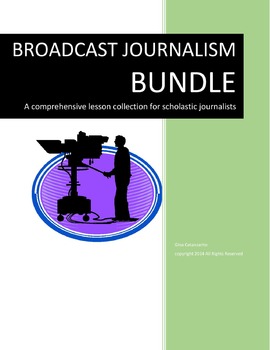
BROADCAST JOURNALISM BUNDLE

Interview Skills | Broadcast Journalism
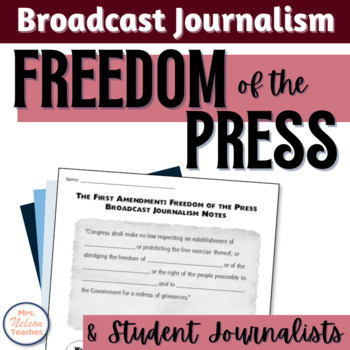
Freedom of the Press Student Journalists - Broadcast Journalism

Introduction to Broadcast Journalism

Entire Year of Do Now Bellringers for Film and Broadcast Journalism Courses

Media Bias | Broadcast Journalism
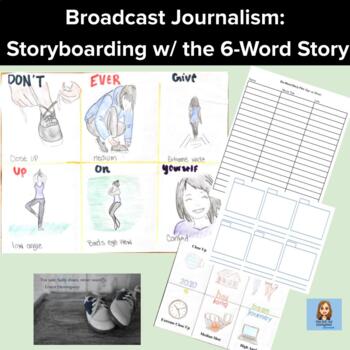
Broadcast Journalism Learn to Storyboard Using the Six-Word Story

Journalism : Broadcast Media & Mass Comm. Projects for Newspaper and Yearbook

Ethics in Journalism - Broadcast Journalism - Reporting

Broadcast Journalism Interviewing Skills Bundle
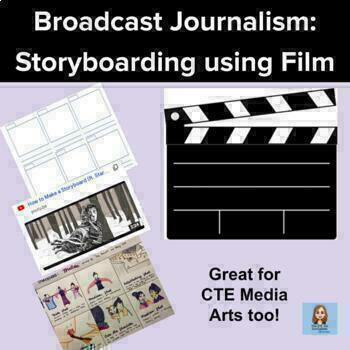
Broadcast Journalism Learn to Storyboard Using Film
- Google Docs™
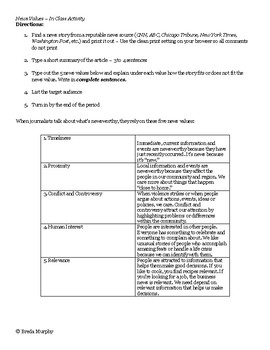
Broadcast Journalism What's Newsworthy Assignment
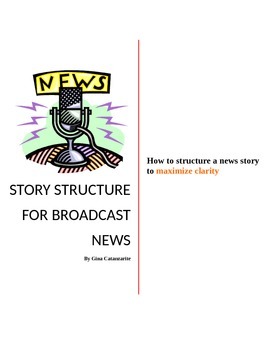
Story Structure for Broadcast News: How to Maximize CLARITY
- Word Document File
- We're hiring
- Help & FAQ
- Privacy policy
- Student privacy
- Terms of service
- Tell us what you think
FiveSeventy
A georgia and student news perspective.
Newscasts produced by the students will be posted on this page.
There are two classes – Tuesday and Thursday. The newscasts will have a DATE headline, so you can tell which newscasts are produced by which class.
A reminder that the students work in teams of three people, with five teams producing the half hour newscasts. They alternate in three key positions — as an anchor, a reporter and as a segment producer. One student is senior producer and one student is assignment manager. It mimics what they would experience in a so-called real life newsroom.
What follows are the newscasts produced so far, starting with the latest one and going backwards.
—————————————————————————————————————————
The newscast below is the one produced by the Thursday class on April 21st. It is their second to last newscast. One more to go. There was a bit of a scramble, in part because they tried something different, mixing up the anchors and reporters, but also because students were dropping scripts and video late. There was some scrambling. It could have been a disaster, but it wasn’t. Let us know what you think.
————————————————————————————————————————————
What follows is the newscast produced by the Tuesday class on April 19th. It is the second to last newscast. And the students were feeling pretty good about it. There has been some marked improvements. Watch and see.
———————————————————————————————————————————-
And the home stretch continues. This is the newscast produced by the Thursday class. It aired April 14th. Since I’ve talked about each one of these each time, I will leave the comments to you…. those of you watching. Here it is —
—————————————————————————————————-
We’re going into the home stretch. This is the newscast produced by the Tuesday class that aired April 12th. The lead story was about the student athletes arrested. Now, it had been reported before, but there were some new ‘twists’ to the story. The “best” part of this exercise for me was that the two student reporters working on this – Maghen Moore and Elizabeth Reid — were very aggressive in pursuing the story and pursuing the sources. The other two stories in what we call the “A Block” was the reaction to the 90 days law in which the athletic association was given the extended time to respond to open records requests. After that was a side-bar piece on G-Day logistics. A little “UGA centric” but the stories were still solid.
Other notable packages were a piece on school discipline, a look at Biotesting and plasma donation, followed by national library week, a look at library services and a profile of a bakery. All light and feature-ish and not the “hard news” we would want, but still well done. See for yourself:
———————————————————————– This is the fourth newscast produced by the Thursday class. It aired on April 7th. Like the others, we see a continuing improvement in the quality of news produced. The only “issue” I would raise is that there continues to be a UGA-centric focus, when we need more of a community-wide focus. Still, a lot of good “shooting” — video quality is up significantly and improvement in overall storytelling.
——————————————————————————————————————————————-
This is the fourth newscast produced by the Tuesday class. It aired on April 5th. The ‘show’ went pretty well, but there was a problem with timing, and stories that went too long. As a result, the senior producer had to ‘kill’ six stories. That is unfortunate because the hard work those people put into getting those stories feels… almost… wasted. It was a learning lesson… that it is critical to watch the time, keep it short and tight. Still, all in all, a solid newscast. Take a look and let us know what yu think:–
——————————————————————————————————————————————————————— This is the third newscast produced by the Thursday class.It aired on March 31st. A little change from the normal. The students had their packages and material ready for inclusion, but it was a day of severe weather. So, we added a new lead– severe weather… just as we would have done if it had been the actual Grady Newsource newscast. The segment producer became the defacto reporter / weather person. We pulled material off the weather.gov website and did the update. Then we went on to the rest of the regular newscast. Anyway, here it is —
———————————————————————————————————————————————————————
This is the third newscast produced by the Tuesday class. It aired on March 29th. At this point, most of the students have rotated through the three positions… most particularly, for the at least… the two on-air positions of anchor and reporter. So, take a look.
———————————————————————————————————————————————-
This is the second newscast produced by the Thursday class. It aired on March 24th. The two classes are different in terms of numbers so there are adjustments to be made in producing a full half hour newscast. Look at the newscast and, yes, think about how they handled being anchors — that’s the most visible role in a newscast. But look at the reporters and not just their on-air appearance. More importantly, Look at, and listen to, the content. We had some issues in this area with this newscast. Overall though a solid production. Then again, you tell us what you think.
——————————————————————————————————————————–
This is the second newscast produced by the Tuesday class. It aired on March 22nd. We should re-emphasize that the students rotate through all positions, so that they have experience as not just an anchor, but also as reporter and producer. The point is to help them see the full, or as close to full, 360-degree picture of what it takes to produce a newscast.
————————————————————————————————————————————————————————-
This is the first newscast produced by the Thursday student group. It’s from March 17th. We had some issues with basic mechanics of producing a newscast — format, scripting, uploading, playback, etc. Despite that the newscast produced was reasonably credible — although we will ask you, the friends, family and viewers, to tell us what you think. What follows is the newscast –News FiveSeventy for March 17th, followed by the post show critique.
————————————————————————————————————————————————————————
This is the first newscast produced by the Tuesday class of the News Five Seventy group. It aired March 15th and it was a strong premiere newscast. It helped obviously that the senior producer was experienced in Newsource, acting as senior production manager, and so he understood the logistics and mechanics of the situation. It also helped that on this first newscast they were able to use the pieces produced for professor Chris Shumway’s videography class. Regardless, we would appreciate any and all feedback.
————————————————————————————————————————————————————————- FROM LAST SEMESTER ——-
On Thursday, December 3rd, the class produced this — the FINAL newscast of the semester for the Thursday group. The lead was the Veterans’ Day observances in the Athens and Northeast Georgia area. It was followed by a story on Extra Special People, people with needs and physical or mental disabilities, the Georgia CARE program, Holiday Mail services and ended with the “kicker” block piece on the Athens Art scene and some particular events going on.
———————————————————————————————————————————–
On Tuesday, December 1st, the class produced this — the FINAL newscast of the semester for the Tuesday group. The lead was the national AIDS Day observance, and events and issues going on in the local area. As with the Veterans’ Day story above, it was a national story, but whereas the Veterans’ Day story above had local events tied to it, on this one the reporters had to development their local angle. As always, the focus on all these newscasts is on the LOCAL stories, not national or international stories. In some cases, a national or international story may be included, as in this, but usually only if —
A) It is of such importance that we need to acknowledge
B) And most likely, if the story is ‘localized’ — that is, a local twist is provided on the story, as happened in this case.
On Thursday, November 19th, the class produced the following newscast. The lead story was a protest in Tate about the reggae situation. It was followed by stories about bike thefts and area robberies in the “2nd” block, a look at apartment utilizes and their costs in the third, LEGBT Awareness in the fourth and ending on an after school celebration at Thomas Lay.
——————————————————————————————————-
It should be noted that this is the Tuesday, November 17th, newscast. The downloading of the newscasts is handled by the volunteer production staff, which is very good about doing this. This was the newscast that led with the story about the shooting in Paris and the fact that a member of the band performing Paris is a member of a band that originated here in Athens, Georgia.
On Thursday, November 12th, the class produced the following newscast. In this newscast, the lead was on the so-called “opportunity zones” which are special tax exempt areas designed to encourage development. It was followed by a story on “Pocket Points”, then a look at the Hunger Bowl drive, a report, or package, on Veterans Day, and finally a look at the Athens recycling program called CHaRM.
A variety of pieces, and a variety of performances. As always, we encourage people to look and share and comment, as appropriate.
One disclaimer: – the production staff that handles the technical delivery of the newscast also is responsible for recording the newscast. As so often happens, the staff begins recording a little bit early to make sure they get the full newscast. In this case, the anchors were… how can we put this… having fun. No harm. But it does serve as a little bit of a warning that you have to be careful any time you’re in front of the camera.
————————————————————————————————————————————————————————————————-
On Tuesday, November 10th, the class produced the following newscast. Frankly, the content was mainly features, rather than what we would call “hard news.” Part of that is understandable because they work on the stories ahead of time and do not normally produce them in full on the day of the news event. Part of it though is also that the students are basically more oriented toward the “lighter news.”
Here were the stories covered: Seasonal Depression especially brought on by the recent poor weather…. a Teen Advisory board which helps local teens cope… the impact of football on the local economy… and a special and different kind of fashion show in Athens.
What follows is the FiveSeventy newscast produced by the Thursday class on November 5th. Again, the stories are pretty “featurish” and again for the same reasons. That doesn’t mean they’re not good. They are interesting, but one of the issues we deal with is making the news stronger and more of a hard focus.
The stories in this newscast were the “No Shave November” move where people stopped shaving for the month to show their support for people with cancer, a look at Hurricane Patrician and the donation efforts locally, the number of Athens pets in shelters, Arts in Athens and the challenges facing print media in this ‘new media world.’
As you can see they are “feature-ish” stories. But the other important part we emphasize is that the stories must ALL be LOCAL. That means they need to be stories about local issues, local events, local people.
(A foot note – For technical reasons, the support crew did not record the Tuesday FiveSeventy newscast from November 3rd.
————————————————————————————————————————————————————————————————
Here is the FiveSeventy newscast produced by the Thursday class on October 29th. To the students’ credit, they did a nice preview on the upcoming local elections, with one reporter (Michelle Baruchman) managing to interview all three candidates for the mayor’s position in Winterville. We also had stories on local coffee shops, a police trunk or treat event and the amnesty law. Unfortunately, one package had to be ‘killed.’ The reporter did not get the script approved by the executive producer in time. Script approval is a critical part of the process. Any script not approved by the executive producer (most particularly, so-called ‘packages’ which are reporter pieces) is in doubt. Some shorter stories, such as readers and voice overs, may be approved by the senior producer on duty. In any case, here it is —
———————————————————————————————————————————————————–
Here is the newscast produced by the Tuesday class on October 27th. The stories ranged from animals at Sandy Creek to the AthHalf Marathon, the so-called Fring Fest and OChem. Don’t know what that is? Watch and find out. You can see it here.
Here is the newscast produced by the Thursday class on October 22nd. It had some good content and some good visuals. So there is progress.
Unfortunately one reporter package was not approved for airing. That meant the newscast was short, so the executive producer had the anchors ask each reporter a question after their package aired, to add substance and depth. Then we had them do a newscast recap at the end of the newscast, to review the stories they had produced.
This was a bit of a curve ball for them. We did it, not just to “fill” time but to provide the student reporters and anchors a real-life experience. It forced them to think on their feet and respond just as would happen in a live newscast. It’s all part of the learning process. In any case, here’s the newscast and the post-show critique as posted on YouTube.
Here is the latest newscast produced by the Tuesday class on October 20th. This is the 3rd newscast produced by this group. We had some issues because what was supposed to be the lead package was uploaded very late to the playback unit for playing on air. So, that meant we had to start with what is called the “B block” newscast segment, then go back to what was the original “A block” newscast segment. In any case, here’s the newscast with the post show review as well, as uploaded to YouTube.
We encourage you to watch all the newscasts and we welcome your comments. We will post the other newscasts as they become available on our video server. We are late posting these because we have had technical problems with the video server and have had to make some adjustments.
———————————————————————————————————————————————————-
The newscast that follows is from the Thursday class, produced on October 15th.
The newscast that follows is from the Tuesday class, produced on October 13th.
————————————————————————————————————————————————————————————————- ————————————————————————————————————————————————————————————————- Below are the newscasts produced by the students in the Spring 2015 class. Below you will find the newscast produced by the Tuesday class and the newscast produced by the Thursday class. We should note there was one “rehearsal” newscast produced before these two. But for all intents and purposes these are the first “real ones.
We post the newscasts on this website from the latest, going backwards to the first ones. You can see them all on this website. The latest newscast for the Tuesday group follows. It is from April 14th. We believe that if you look at this newscast and compare it to some of the first ones, you should see a dramatic difference. But, wait, there’s still one more Tuesday newscast to come — the last of the semester. In any case… here’s Tuesday’s newscast for friends, family… and fans.
Following is the newscast from Tuesday, March 31st. If you look at the newscasts from each night, you will see the student journalists in the various roles… as anchors and as reporters. As noted before, they rotate those positions. The positions you don’t see are the ‘producer’ positions for each group. These people are responsible for seeing that the news segment is structured right and the group is focused. In any case, here is the newscast from Tuesday. If you look at the successive newscasts, you should see a slow but steady improvement.
The newscast from Tuesday, March 24th, had a variety of stories… one on Athlete concussions… the Shuttle service… Car Seats… Work Zones and the New Veterinary Center opening. As always, take a look… give it a critical once over… and let us know what you think.
And below this is the newscast from the Tuesday class, prior to Spring break, that aired March 3rd.
This is the Thursday newscast. The students work in teams of three — a producer, an anchor and a reporter. Each ‘team’ is responsible for producing three to four stories on a single topic. Each topic will be the subject of one whole segment of the newscast. There are five teams of three persons, plus a senior producer and an assignment editor.
This is the Tuesday newscast. We did something a little different this newscast and produced a six-block newscast. The first block was a brief headline service of the top four stories of the day. Each presented by a different student anchor and each one being a VO-SOT. That translates as Voice Over into Sound On Top.
The students rotate through the teams through the semester. That way, each group will work with a different set of students each week. I do this in the belief that this will help them learn to work together and operate as a “team.”
Although a lot of the students’ focus is on their on-air presentation, our emphasis as a journalism program is on the content of their stories… AND that their stories actually be that — Stories. Let us know what you think.
This is the Thursday newscast from November 13th by the Mock Show FiveSeventy students. With this class, there are five groups of students, so each group is responsible for one block of the newscast. Again, there are five “blocks” — normally referred to as the A, B, C, D and E block, or Lead block (A), B Block and Kicker Block (E). As always, take a look and tell us what you think.
And the hits keep coming. This is the Tuesday newscast for the Mock Show FiveSeventy group. Tuesday poses an interesting challenge because there are few students in Tuesday (14 versus 16 in Thursday). Since we break the students up into groups of three, that gives them four groups, with one assignment editor and one senior producer. Each group is responsible for a “block” of news in the newscast.
With four groups, that means four blocks of news. A normal newscast has five blocks of news. That leaves the Tuesday newscast “short” a block of news. Remember, they are supposed to produce a standard 30-minute newscast, which includes five commercials of two minutes each. That leaves 20 minutes of news. It doesn’t sound like much time… until you’re the one having to produce the content.
So, we did something different and had the four “anchors” come back on the set for the fifth block and do a brief wrap-up of their top stories. They had to “ad-lib” much of this, which was a good test of their ability to ‘think on their feet.’ Again, it is something that would happen in the so-called ‘real world’ of broadcast journalism. They did a pretty decent job, but we of course would love to hear comments.
What was also different about this newscast is we had a former student act as Executive Producer. Jacqueline Gulledge, a producer for CNN, graduated nine years ago after going through the broadcast journalism program. She came back and oversaw the day’s newsgathering, writing and producing of the newscast. You can see her and her critique in the post show review which follows the newscast.
This is newscast #5 by the Thursday newscast. At this point, the students are producing a full half hour newscast — running from 7:00 p.m. to 7:30 p.m. with a 2:00 minute commercial outbreak. It is followed by a 20:00 minute long post newscast review and critique. The director and senior producer, in charge of the newscast for that day, provided their feedback and thoughts. The producer of each newscast segment then adds their thoughts to the process. The executive producer / faculty member also provides some feedback and comments for the students. The purpose of all the process is to prepare the students for “real world” production of a broadcast newscast.
It should be noted also that the students are expected to update the website with their stories during the day and then post their “package” as the reporter voiced video piece is called, to the website.
Comments welcome.
The hits keep coming. I believe this is newscast #5 by the Tuesday class. The newscast above has been uploaded to YouTube, like all the newscasts, and is embedded in this website for people to view. We post these newscast — along with the post-show critique session — on this website for students, friends and family to review and comment… but especially — for the students — to review.
This is newscast #4 by the Thursday class. And, again, it is a full-length newscast. In the case of the Thursday crew, this is more realistic to produce a full-length newscast because they have five teams of journalists while the Tuesday class has four teams.
We had several of the teams come in with material of their own already shot… including both B-roll and Interviews. That makes a huge difference in being able to generate a quality product. It also allows them more hands-on experience. It should be noted that the students are taking the videography / editing course at the same time that they’re taking the Mock Show FiveSeventy class. So, that is where some of the material is coming from.
As a side note, on a couple of newscasts, people may have had some problems accessing the video. You may get a warning message that it has been blocked. Interestingly it’s being blocked by the WWE — World Wrestling Entertainment — allegedly for copyright infringement. A double check and a triple check shows that we are NOT using any WWE video. However, there is a Public Service Announcement (PSA) airing within the newscast that draws upon scenes similar to those used by the WWE. Apparently that is enough to set off the WWE alarms. We have challenged it and will continue to challenge it. In the meantime we have dropped the PSA which we believe may be offending the WWE.
As with so many things, it’s all a matter of how you look at it. The bad news is that the newscasts are being blocked by the WWE. The “good” news is that the newscasts are being blocked by the WWE. Obviously that is being facetious, but the point is that the video is getting on the radar screen of a major media operation.
So,newscast #4 by the Tuesday class. And, like the previous Thursday class,they produced a full length newscast. Partly that was done last minute by having the four “anchors” come back and do a brief recap.
That was a wild card I, as executive producer, threw at them. We went into the newscast, knowing we were “short.” When we came to the end, it was clear we were going to be and so I told the four anchors to get back on set and do a brief 15-second recap of their newscast. They did a pretty good job of it, as you can see if you watch the newscast.
The purpose was two-fold. One, yes, they had to have a complete, full-length newscast. We can not “fill” a newscast by just making the stories longer. Some places will do that. That is a dis-service to the viewer and is almost guaranteed to bore the viewer.
The second reason was to give them what really is a real-life situation which does occur. They had to “ad-lib” briefly on a subject. That will happen even in the so-called “real world.” Timing is everything. The ability to “think on your feet” is critical.
In any case, we encourage people to watch and give students feedback.
Now… the third newscast produced by the Thursday class. The rotation continues, and by this point, virtually all of them have had some on-air experience. You can see some differences in how they approach their presentation.
This was the first newscast which hit the schedule times and was truly a full and complete newscast. Most of the earlier newscasts we had the students produce were not full length newscasts. First, we wanted to make sure they understood the gathering and production of the news, and focused on producing material under deadline pressure. Now we added the additional pressure of producing a full 28:00 minute long newscast. And they did it.
In addition to producing the newscast, we added another element to this video on the website. You will see that the video runs longer. That is because we are also recording the post-newscast critique in which the executive producer, senior producer, director and segment producers discuss the newscast. Part of that is technical — how to do certain things. And part of it is logistical. And part of it is presentation.
So, we ask your opinion on these. Now, you can see and hear what the students and staff also have to say.
And the hits keep coming. Here is the third newscast produced by the Tuesday class. As before the students change roles… from anchor to producer to reporter, to give them a broad experience on air and behind the scenes.
As a result of course, for many students, their on air appearance is their first appearance. The challenge is to present the material clearly, concisely… and conversationally. Sometimes the concerns about presentation become the over-riding concerns. While it is extremely important that they can ‘perform’, the most important message we want to send is that their REAL over-riding concern must be the content — what they say, more than how they say it.
Again — comments and feedback are encouraged. To make it more interesting. we have added another element to the newscast presentation. The streaming video also includes the “post-show critique” in which the executive producer, senior producer, director and segment producer review the production. The philosophy is for them to discuss … what went right…. And, NOT, what went wrong so much because things will go wrong as they learn, but more importantly… what could they do better.
This is the second newscast by the Tuesday class for October 7th. As we noted in the welcome page, the students rotate in various groups, so all students will work with each other, and so they all have multiple chances to produce, anchor and report. This session was the second session by the Tuesday group. You will notice a different set of anchors and reporters.
The focus is on getting the information, verifying the information, fact gathering, and then producing pieces. But this is also done under simulated real-life situation, producing the pieces and the newscast under a deadline as if it were “live”. It’s called “live to tape.”
Following each newscast, the students discuss the process with the teacher, looking at what they did right, what they did wrong, and what they could do better.
On presentation issues, they were told to focus on “eye contact” with the viewer. The phrase is the “eyes are the window to the soul.” The viewer wants to make that “connection.” There are times when they want to break eye contact. The simple technique of looking down at their scripts and looking back up between stories does that, and sends a non-verbal signal to the viewer that there is a break, and so there must be a change coming.
On production issues, the concern was that they understand the difference between a Voice Over and a Package. A voice over is when the anchor talks “over” the video appearing on the screen. This is done “live” as the video is rolled by the director during the newscast. In this newscast, the anchors had recorded their voices on the video and then called it a “voice over” which confused the director. A Package can be an “anchor wrap” — that is a story voiced by the anchor and pre-recorded, but it has to be marked as such. Usually, a package refers to a reporter voiced and recorded piece, which includes the reporter voice, and video and the interviews or soundbites from the people interviewed.
We also walked through the issues of defining a One Shot and Two Shot. A “one shot” is a straight head-on shot of the person on set, usually the anchor. A “two shot” is a camera shot, showing the anchor, and the reporter or another anchor together.
On Content, the discussion focused on providing new and updated information. The emphasis was made that they produce their pieces on the basis of what their audience is, but also what time they are presenting the information. The viewers came to the newscast knowing a great deal already, so they must have “new” information or a new “angle” to the story so as to keep the viewers’ attention. The magic part of the word ‘news’ is the word ‘new.’ That of course makes it important that they, the student journalists, keep current on all local and national and international news development. But there is much more emphasis in this course, just as at a local television or digital news operation, on the LOCAL market.
Again — Comments and feedback are welcome.
This is the second newscast by the Thursday class. It was produced on October 9th. As above, you will see a different set of students in the roles of anchors and reporters. The students are rotating through each of the positions to give them a broad experience.
Here are a couple of criticisms / suggestions from the executive producer.
On presentation — they were told to face the camera straight on… do not look sideways towards the camera… sit up straight and be forceful in presentation… AND don’t smile, at least don’t smile on serious stories. Too often people nervous on air will smile inappropriately. They’re talking about death and destruction and they are smiling. It may be out of nervousness, but it sends the wrong signal.
On production — The women, in particular, were told to watch their hair and microphone position… too often, their hair is brushing into the mic and causing audio problems and noises. They were reminded, again, to drop their packages early. The phrase “drop” means filing a story on the video server. A compliment that they are using full screen graphics and getting them done and posted.
On content — The full screen graphics are adding more depth and facts and figures to the story. They needed to make sure they sourced the material properly. The anchor can’t just read or say a list of things without indicating where the information came from. There were some concerns raised that they had not done enough research to find all the various sources of information on any given topic. But we know there will be more of that in future.
As always, comments and feedback are encouraged.
Leave a Reply Cancel reply
Save my name, email, and website in this browser for the next time I comment.
- Share full article
Advertisement
Supported by
current events conversation
What Students Are Saying About Why School Absences Have ‘Exploded’
Chronic absenteeism has increased in American schools since the Covid-19 pandemic. We asked teenagers what they make of the trend.

By The Learning Network
Nationally, an estimated 26 percent of public school students were considered chronically absent last school year, up from 15 percent before the Covid-19 pandemic, according to the most recent data, from 40 states and Washington, D.C., compiled by the conservative-leaning American Enterprise Institute.
The increases have occurred in districts big and small, and across income and race.
In “ Why School Absences Have ‘Exploded’ Almost Everywhere ,” Sarah Mervosh and Francesca Paris explain:
The trends suggest that something fundamental has shifted in American childhood and the culture of school, in ways that may be long lasting. What was once a deeply ingrained habit — wake up, catch the bus, report to class — is now something far more tenuous. “Our relationship with school became optional,” said Katie Rosanbalm, a psychologist and associate research professor with the Center for Child and Family Policy at Duke University.
In a related Student Opinion question , we asked teenagers if that explanation resonated with them. Had their relationship to school — and school attendance — changed since the pandemic? And if so, what did they make of this shift?
Many students said, yes, school feels different now. Why? They pointed to remote learning changing their routines, an increase in anxiety and a decrease in motivation, the ease of making up schoolwork online and much more. Read their responses in full below.
Thank you to everyone who participated in the conversation on our writing prompts this week, including students from Central Bucks South High School in Warrington, Pa .; Norwood High School in Norwood, Mass.; and West Salem High School in Salem, Ore.
Please note: Student comments have been lightly edited for length, but otherwise appear as they were originally submitted.
Remote learning made students comfortable with missing school.
I believe that there are two main contributors to missing school too much. The first is online school. Myself included. It was very easy to simply leave the call after taking attendance and the teacher wouldn’t realize. Skipping class was easy and you could still get high grades. Transitioning back to real school, kids still held that true. They knew that they could miss school and still do well because covid taught that to them. The second reason is punishment. When you miss school, nothing happens. Class goes on and you have a little extra homework the next day but that’s it. What is the issue with missing class is a very common thought and it’s true. There is very minimal downside to missing school. When I had surgery, I missed a full week of school and within a day and a half, I was fully caught up again. Missing school has just become all too easy.
— Xavier, Pennsylvania
2020 was when our lives completely changed for the worst. We all had to stay inside and stay separate from each other. It was terrible, not being able to talk to my friends, and seeing the death toll on news constantly rise. However, after a year into the pandemic, I believe students realized the power they now had, including me. Now that I am a highschooler, I am going to admit that sometimes I would just mute my class and do whatever I wanted. School became shorter and easier to pass than ever before. That’s why when we all transitioned back into school, it was weird. We all still wanted to get through class the “easy way,” yet now that we were back, it wasn’t possible. This is why we started increasing our absences. The threat of absence has become weak, students are not as afraid to stay out of school. Furthermore the threat of being infected gave just one more reason to be out of school, for the sake of “preventing others from getting sick,” when in reality you feel fine. That is most likely why the absences in school had an exponential increase.
— Joshua, Pennsylvania
Students feel like expectations are lower than they were before the pandemic.
As a student in high school, I’ve come to realize the horrible state our attendance has been in since the pandemic. The reason can be simplified into one idea: laziness. We are lazy, willing to do only enough to get by, no more, no less. If a student doesn’t need to come to a class to obtain the grade they wish to achieve, then they won’t show up. Classes are not challenging enough to make students feel that they are worth going to. My mom is used to getting texts from me during the school day, begging to be excused from a class where “we’re doing nothing” or, “I already finished the work,” which is true, yet I abuse the opportunity to miss class because I know there will be no greater coincidence, I will still be getting an A. Due to my laziness, I would rather be at home taking a nap than sitting in a class with no greater impact on my life.
— Clara, Salem, Oregon
Since the pandemic, schooling has been focused on getting students caught up to where we’re supposed to be. Consequently, more allowances are made for students who don’t do assignments or don’t even show up. And with the switch to all online because of the pandemic, things have never shifted back. If a student misses a day or even a week, they can easily see what they missed and do it and submit it from home. With this option giving them the exact same grade as it would if they actually went to school, it’s no wonder why students are choosing to stay at home or skipping class. Additionally, the pandemic had heightened anxiety levels in students, specifically social anxiety, making them less likely to show up. The allowances made by the school district for students has created a space for students to be lazy and get away with it. This is fostering a negative impact on student work ethic not only now, but also in the future when this generation will be entering the work force.
— Emma, West Salem High School
The period of school shutdowns got students out of their school routines.
When I think back to virtual learning, my brain automatically goes to how stress free it was. I was in sixth grade when Covid first hit and going through a period of my life where I was extremely anxious at school. I believe that this break is exactly what I needed at the time. However, I do believe that in the long run, this online learning time period got a lot of people into the routine of not having a routine. A lot of people at my school would turn their camera off and fall asleep or go on their phones during online learning. I believe that there were times that I did this as well. I also think that this mindset carried through into the grades where I did not have an online/hybrid option. In eighth and ninth grade, I happened to stay home sick, go into school late, or leave early a lot. I think this is due to me not taking school as seriously due to the grading methods that were being used and how some of my teachers were not grading harshly. Now that I am a sophomore in high school, I think I have finally gotten back into the routine of actual schooling and not staying home sick unless I actually feel extremely sick.
— Madison, Pennsylvania
Before the pandemic and as I was growing up, I was the kind of student that wanted perfect attendance. For some odd reason, it made me feel like a better student if I never missed a day. This included turning my parents down when they offered me to go on trips, even though I was only in fourth grade and the work that I would have missed wouldn’t have made an impact in my academic career. However, after the pandemic school began to feel optional. We felt what it was like to fall out of the routine that going to school was and were never able to fully recover from it. I think that having experienced attending school from your bed, in your pajamas has played a major role in the current trend of students receiving more absences. For me, it made me realize that the “0” next to your number of absences didn’t matter as much as I had once thought. As a now highschooler, the school days are long and every class requires an abundance of work and undivided attention that whenever there is a substitute or not much going on, it is easy to decide to leave school. With senior year approaching, everything’s purpose is college and the fact that colleges aren’t able to see how many absences a student has when they apply, does play a role in the increasing number of absences.
— Ava, Miami Country Day School
Because assignments and other materials are online, students find they can keep up with their classes even if they don’t attend school.
Schools have adjusted rules so much that it makes school feel optional. Don’t want to attend class publicly? Take online classes. Don’t want to take “required” state testing? Opt out. Before, school seemed strict, we didn’t have the option to opt out of tests, we didn’t think of taking online school. Yet now, schools make it so easy to skip because everything is simply online. Our assignments, lectures, and teachers are all online. There are no longer requirements in school. What’s the point of attending if we can graduate without taking state testing or attending advisory — also a requirement, yet I no longer have an advisory because my counselors said I don’t need to take it to graduate. It’s confusing. Students have been enabled for over 4 years now since quarantine started. School doesn’t feel mandatory, it’s optional. I’m currently enrolled into 2 AP classes, so I try my best not to miss school. But it’s inevitable, I get sick, I have family situations or maybe I simply don’t feel like attending school. But I see people skip school like nothing. “I didn’t feel like going” is a constant statement I hear. Not many students have the motivation to attend, and simply don’t go because they have a comfort in their head that they can graduate while missing multiple days of school nearly everyday.
— Olivia, Salem, OR
Current absenteeism rates have significantly impacted my learning experience for the past few years. Since the pandemic, there has been a noticeable shift in the perception of the value of education and whether or not attendance is an important factor in a student’s academic success. In the years following 2020, I found myself struggling to make it to class everyday due to my new found efficiency of working at home with my computer. I felt that even if I was not in class personally, I would be able to keep up with my work easily as it was all online regardless. Due to this I would go on trips or skip class purely because I was under the impression that I would be able to continue achieving virtually.
— Ruby, RFHS
Before the pandemic, my attendance was stable but after the pandemic, my absences were piling on. It was difficult to get back in the rhythm of in person school when I had already done a whole year online, but now my attendance in school is definitely getting better. On the other hand, students in my school tend to miss school and it is a rare sight to see a full class. Some students go as far as showing up to class once a week and just do the classwork online. After the pandemic, schools went from paperwork to all online, which is a big reason why students miss all the time, knowing that school work can just be done at home. It has definitely affected students’ grades and goals in life, but hopefully in the future, absences can lower back down.
— Emily, Atrisco Heritage Academy High School
Going to school, and finding the motivation to have as good an attendance record as possible, now feels like more of a struggle.
As students, we’ve developed a comfort in staying in bed during school without having to get ourselves ready to go outside. We had the ability to wake up five minutes before “school” started to get on our zoom calls. Now, we must wake up an hour and a half prior, and make breakfast and pack lunch, before driving to school. The process is tenuous as the article states, but because we’ve accustomed to a different lifestyle, it just makes this one seem like so much more work. I, myself have noticed my difference in attendance after COVID-19. I used to be very obsessed with perfect attendance, but I had 11 absences in my sophomore year, right after coming back from online school. Nowadays, I’m more lenient on myself when it comes to taking a mental health day, because the process can be overwhelming. School is very important, so of course I try to always come in, but sometimes it can be hard. I have not noticed this trend in the world, as well as with myself until this article. It’s enlightening to know that this had not only an effect on me, but all over the country. Hopefully the rates of absenteeism will decrease as time goes on, because we are the future.
— Anisha, New Jersey
Before virtual learning, I never made much of a habit of not turning in work or showing up for class. It was so much easier then but since virtual learning, it had become incredibly difficult for me to focus as well as keep up motivation to continue school. It was easy to skip and nobody really said much about it so it easily became a bad habit. That bad habit eventually leaked into normal school as well and it always sounds so much easier to break out of than it actually is.
— Tayy, NRHS
As the average high school class skipper (only sometimes), in my personal experience, missing out on classes hasn’t really been because of mental health concerns, but more of just lasting laziness from the pandemic. I feel as though I was relatively hard working in middle school/elementary but after a few years off with only half effort assignments, I have grown to become more sluggish and reluctant when it comes to more advanced work while in school. And it makes the option of missing out on classes because of my own reluctance a lot more appealing.
— Luke, Bali, Indonesia
My schedule during the week is get up, get ready for school, go to school, go home, do homework, go to sleep and then I repeat that everyday for 5 days. As much as I don’t want to dread going to school, it’s exhausting having the same schedule repeated everyday of the week. While in school, you have assignments assigned nearly everyday. I feel as though school has had a change in its meaning because of the COVID-19 pandemic. While in quarantine, we were looking at a screen for the whole day and lacked motivation to get assignments done. When we shifted to in person school again, it didn’t change. I now look at school as a task that I need to complete to shape my future. I need to have all my assignments perfect and turned in on time. The meaning of school has turned into a draining task rather than a place that you look forward to going to.
— Jamisan, Salem, Oregon
Some students face challenges in attending class that may have nothing to do with the pandemic.
I don’t believe that students are skipping because it is so easy to catch up and pass, despite their absences. In fact, I know that a lot of people who skip aren’t passing most of their classes. They do this because their parents don’t hold them accountable, and there is always something deeper going on in that student’s life that makes it that much harder for them to find the motivation to go to class. I don’t think making the classes harder will hold students more accountable, but in fact deter them from going to class at all. If a student is aware that they are failing and doesn’t understand the concept of the class, and the class proceeds to become harder, they are going to quickly become unmotivated to go to class in the first place, feeling out of place compared to the other — passing — students in the class. While I don’t have a solution for this problem, myself, I feel that the problem is much broader than we suspect, and the answer will be a much deeper journey to find.
— Kylie, West Salem HS
Schools can do more to get students back in class.
I attend a French school in London and attendance is closely monitored. Absences have to be justified by your parents or you could get into trouble. I think it’s important to attend school as we did before Covid - because as well as learning the curriculum, it is crucial to socialise with your friends and classmates, which is good for your mental health … I wonder if social media could be a factor? If students did not have access to social media or the internet, would they prefer to be in school with their friends? This increase in absenteeism could affect students’ chances of getting into University when they come to finish school or even their opportunities later in life. Students need to be reminded of this more and more perhaps. School helps you to learn not just about facts but also helps to build your emotional quotient & social intelligence — which are all valuable for life.
— Alexandre 14, London
As a current high school junior, my experiences with skipping have been minimal at best, however, I feel strongly that the reason behind skipping is pretty simple. Students don’t care as much about school and the system encourages it. When faced with the choice of sitting in a class and learning about the Patagorian theorem or hanging out with friends, many students are now choosing the latter. The lack of care or effort being put forth in school doesn’t even affect their grades! This is due to certain classes having minimal grades set at 50%, which is 10% away from a pass. This system is actively encouraging people to put minimal effort into a class just to get a pass and graduate. Removing courses like this would certainly raise the importance of getting the work done. Another solution to this problem would be having attendance as a grade, if your grade depends on you being in classes then most would show up. If you have to show up to class to pass then more students would be inclined to do so. The emphasis is on not bending the knee to people who don’t want to show up to class, not giving them a minimal 50%, we should mark attendance for a passing grade, and letting them fail. If we keep letting students skip with minimal consequences then their attitudes won’t change and thus hinder our students’ growth.
— Henry, Salem, OR
Learn more about Current Events Conversation here and find all of our posts in this column .
- WEATHER ALERT Flood Warning Full Story
- chicago public schools
Teacher's aide at CPS elementary school taped students' mouths shut, parents say

CHICAGO (WLS) -- Parents of students at Woodson Elementary School in Bronzeville said a teacher's aide taped multiple students' mouths shut.
They said they were initially told it happened during what was described as a fun assignment, but they said they later learned this was anything but fun and games.
ABC7 Chicago is now streaming 24/7. Click here to watch
A Woodsen parent said she received a phone call from a teacher's aide about a game allegedly played in her 5-year-old son's kindergarten classroom. That parent asked for her face not be shown.
"Never, not once she said what the game was. She never said anything about tape," said Jil, who would only give her first name.
Then, Jil said, she got another call moments later from the school's principal.
"Stating that an incident has taken place with a tape. They never said what kind of tape. All I knew was my son was taped," she said.
Rachel Beverly's 5-year-old daughter is in the same class.
"The T.A. told the principal that they were having a spelling bee, and they didn't want all the smart kids to blurt out the answers, so they duct taped their mouths," she said.
"He said, 'Mom, my mouth was taped because I was talking,'" said Jil. "Right then, I knew it was a problem. That was a big problem."
The Illinois Department of Children and Family Services confirmed to ABC7 that "DCFS is investigating this report, and the investigation is currently open at this point in time."
ABC7 is not naming the staffer as charges have not been filed.
Chicago Public schools shared a letter with ABC7 that was sent to parents this week that read in part, "There have been allegations that one of our staff members engaged improperly with students... An investigation has been initiated by the Office of Student Protections and Title IX (OSP), and this individual has been removed during the course of the investigation."
The letter goes on to say, "We are taking this situation seriously, and we remain committed to providing your children with a safe, positive learning environment where they can reach their full potential."
School leaders said they will determine at a later date whether the teacher's aide can return to the school depending on the findings of the investigation.
Related Topics
- BRONZEVILLE
- CHICAGO PUBLIC SCHOOLS
- DEPARTMENT OF CHILDREN & FAMILY SERVICES
Chicago Public Schools

Former student files sexual abuse lawsuit against CPS

CPS principals getting 1st look at budgets under new formula

Chance the Rapper remembers CPS teacher assistant hit, killed

CPS teacher seeks to open 1st bookstore in Roseland
Top stories.

Chicago Jewish leaders refuse meeting with Mayor Brandon Johnson

81-year-old pizza delivery man carjacked on Northwest Side: CPD

Hazmat team called after fire breaks out at River North high-rise: CPD
- 3 minutes ago

Eleanor Coppola, matriarch of a filmmaking family, dies at 87

3 people robbed at gunpoint within 15 minutes on North Side: CPD
Cook County taskforce tries to stem tide of organized retail theft
Rep. Jonathan Jackson criticized for comments on Chicago firefighters
Chicago Weather: Sunny and very nice Saturday
- On the Border
- ABC-7 Alert Center
- Military-Fort Bliss
- Watch a Newscast
- ABC-7 StormTrack Doppler
- El Paso Chihuahuas
- Watch Locomotive FC
- Texas Politics
- New Mexico Politics
- Watch Live Events
- Borderland Crimes Podcast
- Community Champions
- Borderland Experts
- Good Vibes Only
- Sunday Funday
- Entertainment
- Events Calendar
- KVIA Careers
- Borderland Careers
- Contact KVIA
- People of ABC-7
- Closed Captioning
- EEO Public Filing
- FCC Public File
- KVIA Jobs and Internships
- Download Our Apps
- History of KVIA ABC-7
- TV Listings
EPCC Computer Science students attend global symposium for their winning assignment

EL PASO, Texas (KVIA) -- Two EPCC Computer Science students, Ivan Alonso and Emilian Garcia, took their winning assignment, "The Fingerprint Assignment: An Interdisciplinary Assessment for CS I Education" at the Technical Symposium of the Special Interest Group in Computer Science Education in Portland, Oregon.
Alonso and Garcia, with the help of their professor, Dr. Christian Servin, presented their work on March 20th through the 23rd at the symposium.
The team's work was considered among the top six assignments globally for the current year. This is also the first time the session has accepted an assignment from a community college.
Alonso said the work he and Garcia did was challenging, but allowed him to have a deeper understanding of computer science. “Through participation in this research, I discovered knowledge beyond the classroom,” Alonso, said. “Engaging in research exposed me to real world applications and challenges, which fostered a deeper appreciation for the complexities of the field.”
Jump to comments ↓

Valeria Medina
Related articles.
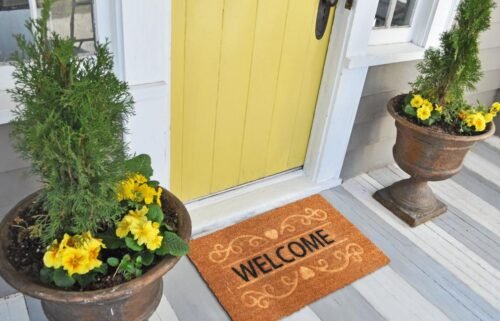
Counties with the lowest cost of living in Texas
How o.j. simpson burned the ford bronco into america’s collective memory, biden’s ballot access in ohio and alabama is in the hands of republican election chiefs, lawmakers, some fear university of michigan proposed policy on protests could quell free speech efforts.
KVIA ABC 7 is committed to providing a forum for civil and constructive conversation.
Please keep your comments respectful and relevant. You can review our Community Guidelines by clicking here
If you would like to share a story idea, please submit it here .

IMAGES
VIDEO
COMMENTS
Lesson 3.2: Team Work and Planning. Hey, we moved! For all updated lesson plans, visit StoryMaker, a dynamic resource platform designed for educators to help your students become confident, powerful storytellers. Read More. Think. Create. Inform. PBSNewshour Student Reporting Labs lesson plans.
Students use Common Core skills (such as use charts, graphs, photographs, videos, and maps), creativity, and higher level thinking skills to create a Newscast on any topic you choose. The product comes as an editable Word document (the example is on Martin Luther & The Reformation). This activity encourages the students to apply knowledge that ...
Creating a Newscast as an ESL Lesson. Media is an ever-present reality and one that students are intimately familiar with. As such, diving into the media landscape offers multiple avenues for interesting lessons that will hold students' attention. You can start by studying media-related words so that students are familiar with the basics.
Divide the students into teams of between three and six. Depending on the story, each team will have: An anchor, who hosts the show and delivers the headlines and the basic details for each story. A correspondent, who is based in the location of the story, or nearby. An expert, who can add detail or contextualize the story.
2. Choose a strong communicator to be the writer. A newscast is typically written by one writer, or a team of writers. Pick someone who is good at communicating on paper and who has an ear for writing dialogue. They will then write each news segment so the language and tone flow well together in the newscast.
6. Wrap-up - closing of newscast STAGE ONE: Previewing As a practice assignment, students are asked to view sample TV newscasts. As you are watching the news, pay attention to: - the order of events (e.g., national news, international news, sports, entertainment, weather, human interest or feature stories, commercial interruptions, etc.)
This will allow different students from your group to play the role of reporter, the person being interviewed, and the commentator (in the case of editorials). Once your scripts are written, assign each person in the group to play a "role" in several stories. Decide on the flow of your newscast and write all of the transitions that will ...
The following is a class activity in which students are placed into groups and assigned the task to create a "Newscast" to inform the audience about the Russian Revolution of 1917 and the subsequent Civil War in Russia which follows a few years later. For this assignment students are asked to create
A great assignment to introduce news stories and newscast work! Students can do this at home or as a class activity. This assignment will teach students how a newscast is structured, what's newsworthy, and how reporters and anchors work in the field to put together their stories. Grading rubric for written assignment included.
It's time to create your own student newsroom. A student newsroom is a great way to increase engagement, creativity, and learning within the classroom. What's even better is that your students are the video producers of their own newscast. You can guide students in their learning by assigning stories or topics.
p.406 Newscast NOTES a homework assignment the night before the activity is to begin or to view at least two during a weekend prior to the beginning of the activity.] ... In order to create their newscasts, students are to research print (actual magazines and newspapers as well as on-line sources) and television or radio media (cable channels ...
Using a School News Program to Promote Positivity During the Pandemic. An elementary school newscast is bringing kids together and giving them a reason to smile during a tough year. By Ashley Blackwelder. November 2, 2020. Courtesy of Ashley Blackwelder. A student at the author's school delivers the news.
In fact, this rule is also applicable to newscast production and all script writing that is to appear in a teleprompter. With current demands placed on broadcast instructors and the limited time available for you to prepare your students, the best way to ensure a well established news gathering and production process is to implement a Newsroom Computer System (NRCS).
Video Production of a Newscast - Lesson. Level (s): Grades 6 - 9. Author: This unit was created by Stephanie M. Rusnak, B.S.Ed, of Charleston, South Carolina, as part of a Media Production Course. Overview. In this lesson, students will produce a 20 minute news broadcast. In teams of 4-5, students will create and film a two minute segment of a ...
THE PROJECT: Students will be assigned to teams of 4 - 5 students. Each team is expected to write, rehearse, and perform an approximately 5 - 10 minute newscast. Each team will be given a different Egyptian social level to address in their newscast (Government Officials, Priests, Scribes, Artisans, or Peasants) that will focus on Daily Life in Ancient Egypt.
Student Production -- Newscast• Diana Gonzalez: One Year Anniversary Special, Neiko Will, James Smith, San Diego City College• Occupy Up close, Neiko Will, S...
CNN 10 is a daily news show for students over 13 and other viewers who want to learn about current events and global issues in 10 minutes or less.
The Media Law Newscast Assignment is a research-based production where students work in small groups to research, analyze, and frame a current issue in media law. Each group of 4-5 students produces a 4-6 minute audio or audio-visual news segment to present their research to the class. The learning objectives for this assignment include: 1 ...
An engaging Slides Presentation will teach your students the content, note-taking pages will help students retain the information, and students will participate in a newscast evaluation assignment that will help them become more familiar with the world of Broadcast Journalism.Topics Covered:Broadcast JournalismBeginnings and History of Bro
The talented students at C19TV are putting their skills to use. Students tackle both national and local issues in this newscast.
A reminder that the students work in teams of three people, with five teams producing the half hour newscasts. They alternate in three key positions — as an anchor, a reporter and as a segment producer. One student is senior producer and one student is assignment manager. It mimics what they would experience in a so-called real life newsroom.
April 11, 2024, 2:27 p.m. ET. Nationally, an estimated 26 percent of public school students were considered chronically absent last school year, up from 15 percent before the Covid-19 pandemic ...
CHICAGO (WLS) -- Parents of students at Woodsen Elementary School in Bronzeville said a teacher's aide taped multiple students' mouths shut. They said they were initially told it happened during ...
Meanwhile, while fewer faculty members used AI, the percentage grew to 22% of faculty members in the fall of 2023, up from 9% in spring 2023. Teachers are turning to AI tools and platforms ...
Two EPCC Computer Science students, Ivan Alonso and Emilian Garcia, took their winning assignment, "The Fingerprint Assignment: An Interdisciplinary Assessment for CS I Education" at the Technical ...
Robert MacNeil, who created the even-handed, no-frills PBS newscast "The MacNeil-Lehrer NewsHour" in the 1970s and co-anchored the show for with his late partner, Jim Lehrer, for two decades, died ...